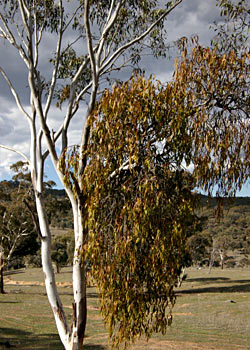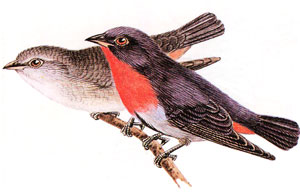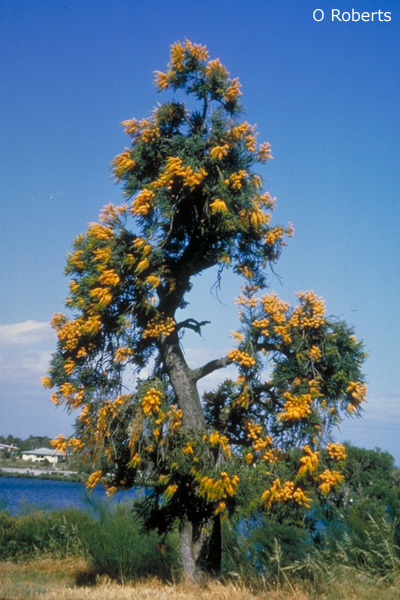
Mistletoe - Part 1
Marion Jarratt
Note: This article originally appeared in 'Brigge', the newsletter of the friends of Burrendong Arboretum. The Arboretum is located in the central west of New South Wales, near Wellington.
Visit the Burrendong Arboretum website
Personally I have a big problem with mistletoe as I can see only too clearly that it is killing many of the trees on my property, Canobla, in particular Blakely's Red Gum and the local ironbark, Eucalyptus sideroxylon. However, after researching the subject fairly thoroughly for a radio interview, I must concede it is an enormously enterprising plant with a surprisingly long association with western culture.
| |
 |
| |
A clump of mistletoe on a
Eucalyptus sp.
Photo: Brian Walters |
In pre-Roman times the Gauls believed that mistletoe was a plant of special significance, probably because it fruited and flowered in mid winter, and that it was sent direct from heaven. They also held oak trees in especial veneration as a symbol of power. The combination of mistletoe and oak (quite an uncommon occurrence) indicated the heavens had selected this spot as a shrine. The Druids would cut mistletoe branches with a golden hook and use them to burn sacrificial animals at the foot of the host oak.
Druids, impressed by the ability of the mistletoe to flower and fruit when few, if any other plants could, ascribed to the plant the power of fertility and made it a symbol for fecundity. Herbalists developed this and prescribed mistletoe twigs and berries to assist conception or increase chances of marriage for the unmarried. In fact, over time, it came to be prescribed for rheumatism, gout, spasms delirium, neuralgia, heart diseases and St Vitus Dance! A real cure-all!!
The linking of mistletoe with the English tradition of kissing under the mistletoe did not occur until the 17th century and was an obvious development of early pagan rites.
There is also a rather charming, but very unlikely, legend associating mistletoe with Christianity. The story goes that the Cross was made from mistletoe wood and, as punishment, the shrub was banned from the earth, having to make its living as a parasite dependent on other plants. There are still places in Brittany where it is known as "Herbe de la Croix". The English name actually comes from the Old English "mistletan" which was derived from the Old Norse meaning twig.
So much for cultural associations, now for the botanical side!
 |
|
Male and female Mistletoe Birds
Illustration by Neville Cayley (1886-1950) from the Australian National Botanic Gardens web site
|
|
Mistletoes are flowering plants which belong to one of three families [Loranthaceae, Viscaceae and Eremopolepidaceae]. All mistletoes show some degree of dependence or parasitism on a host plant. Australia has a fair share of the world's mistletoes with 13 genera and approximately 90 species out of a total of 60 genera and 700 species and they occur in virtually every type of woody vegetation across the mainland - mangroves, rainforest, alpine areas and desert scrubland. They should be termed hemi parasites as they do produce their own nutrients from photosynthesis but are dependent on their host for water and mineral nutrients.
Amazingly, Tasmania has no mistletoes although it certainly has the host plants that carry mistletoe on the mainland. One reason may be that mistletoe never evolved in Tasmania and there have been no seed vectors to spread it there. For instance, mistletoe birds have been blown [and can actually fly] to Tasmania but their gastro-intestinal tract is so specialised that mistletoe seeds are voided within 25 minutes of ingestion - hardly long enough for the flight to Tassie! Another bird that eats mistletoe seeds is the silver eye. Not being as specialised, silver eyes retain the seeds for much longer, so that they could transport the seeds across Bass Straight. Also silver eyes migrate each spring from many points on the mainland across to Tasmania. However, they do not carry the seeds across into Tasmania because mistletoes are not fruiting during the migration period. There are simply no fruits to carry across.
 |
|
Western Australian Christmas Tree
Nuytsia floribunda
Photo: Owen Roberts |
|
Mistletoes in Australia are mainly aerial parasites attaching to their host above ground, although a few are free standing and parasitise the roots of other plants. For example Nuytsia floribunda, the Western Australian Christmas Tree is free standing but parasitises the roots of surrounding grasses and shrubs. One of the most spectacular Australian mistletoes and the largest mistletoe in the world, this species with its massive summer display of tangerine coloured flowers makes the traditional European Christmas mistletoe pale into insignificance. It looks just like a free-standing tree, but it seeks out the roots of its neighbours and has even been known to invade PVC-wrapped telephone cables in its voracious search for nutrients!
Most Australian mistletoes are host specific meaning they can survive only on one or a few tree and shrub species in a district and most rely on birds for pollination and seed dispersal. The mistletoe bird is the principal seed disperser of Australian mistletoes and lives on little else. The painted, the spiny-cheeked and the striped honeyeaters feed on mistletoe fruits and are likely to be locally important seed dispersers.
Mistletoes have lots going for them - especially with board (much of it, anyway) and lodging provided. Their flowers are big and colourful - just right for attracting birds; their foliage is nutritious and almost succulent so it attracts mammals; their fruit is tasty and eagerly sought after; and they have extended flowering and fruiting periods. BUT they are really living on a knife edge, in the fast lane at it were, because they are totally dependent on outside agents for pollination and seed dispersal and that, for a plant which is strongly host specific, is critical.
In Part 2, I'll complete this article by describing the life of the mistletoe and writing s little about the 'new'íthinking on mistletoe - its importance as habitat and its role in increasing biodiversity - as well as looking at predators, methods of control and why so many of us feel mistletoe is spiraling out of control. And if any of you know why there is no mistletoe in Tasmania, please write and tell.
From 'Brigge', the newsletter of the Friends of Burrendong Arboretum Inc., April 2006.
Australian Plants online - 2008
Association of Societies for Growing Australian Plants
|